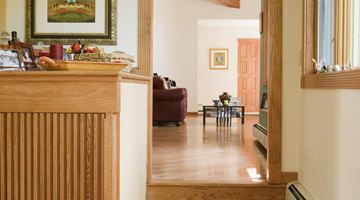How to Keep the Lower Level of a Bi-Level House Warm

If you are uncomfortably cold in the lower level of your bilevel house in the winter, you can blame the natural tendency for warm air to rise. As it rises, it creates a convection current that draws air through any gaps or cracks in the windows or siding to replace it. You can counter this by better insulating the entire house and providing more warm air downstairs with floor-level heaters.
The Stack Effect
The tendency of hot air to rise creates an air pressure difference that can result in a considerable upward draft. This phenomenon, called the stack effect, can be strong enough in high-rise buildings to make it difficult to open the doors on the ground floor, and it was probably one of the reasons why revolving doors were invented. If you have a ground-floor fireplace, you can get first-hand experience of this effect by putting your hand in the chimney flue and feeling the wind rushing by. This draft creates a void, and to fill it, air rushes into the room from wherever it can -- usually from outside.
Proper Insulation
The first step toward a warmer ground floor is proper insulation, which includes weather stripping around all doors and windows and caulk around all the trim. Single-pane windows readily allow cold air to come into the room and should be replaced with double-pane ones. It's also important to properly insulate the upper level of the house to prevent warm air from escaping because that creates a void that sucks more warm air from downstairs. Ways of sealing the upstairs against heat loss include sufficiently insulating the attic as well as installing insulated windows -- or at least recaulking the existing ones.
Floor-Level Heating
You can't completely eliminate air circulation from your house or air quality will suffer. You can reduce it, however, and when you do, more warm air will stay downstairs. If you don't have central heat, you may need another source of heat there. It should be as close the to the floor as possible so that even if some of it is drawn upstairs, more will be available downstairs. Baseboard heaters are one option. Another -- if you're considering remodeling -- is radiant flooring. If the house is on a concrete slab, you can install radiant flooring under a raised plywood subfloor and cover it with tile, hardwood or laminate flooring.
Central Heating and Landscaping
If your house has central heating, it should be designed to compensate for the stack effect. The intake vents should be upstairs, and the downstairs heating vents should be as close to the floor as possible. If you're cold, you may need a heating, ventilation and air conditioning professional to help you redesign your heating system. Depending on where you live, some landscaping changes may help keep you warmer. You could provide a wind buffer by planting rows of coniferous shrubs along the sides of the house, leaving windows exposed so they pass warming sunlight into the house during the day.
References
Writer Bio
Chris Deziel has a bachelor's degree in physics and a master's degree in humanities. Besides having an abiding interest in popular science, Deziel has been active in the building and home design trades since 1975. As a landscape builder, he helped establish two gardening companies.
Photo Credits
- Jupiterimages/Stockbyte/Getty Images
- Jupiterimages/Stockbyte/Getty Images
More Articles



